page 1
Progressive Thinkers as of 5/8/2020
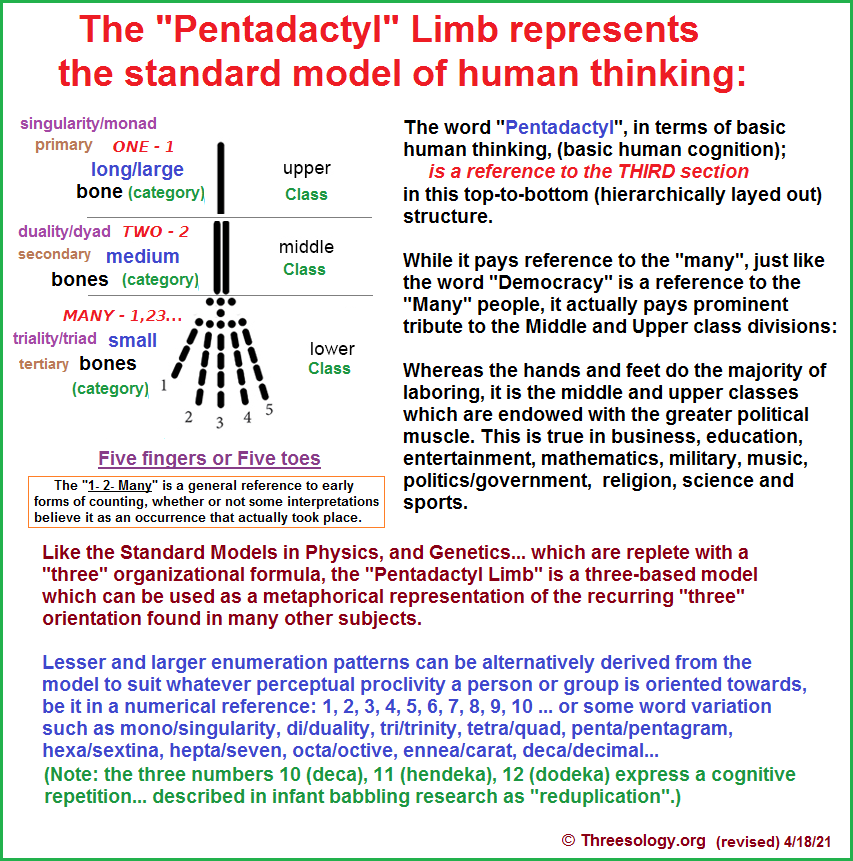
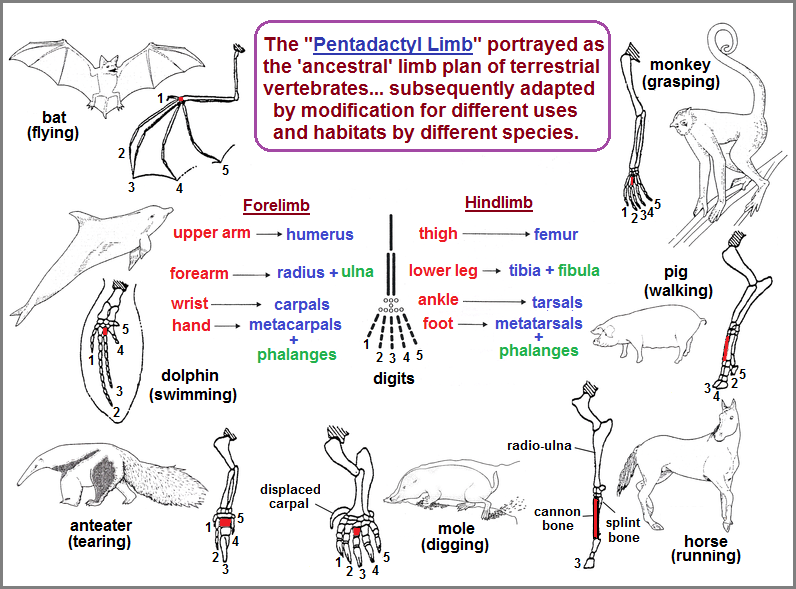
Not only can we see a standard cognitive model represented in the Pentadactyl Limb, but also the Rock-Scissors-Paper trio. Permit me to list a few examples, whether you want to agree with them or not, because your first reaction is to identify some idea which you have esteemed as having no equal... thus revealing your ego gets in the way of seeing basic commonalities due to developed prejudices and discriminations. The following examples portray correspondences without any detailed explanation as they come to mind as basic correlations. This list is a small portion of the information to be used on the "Rock-Scissors-Paper" series. Please note the overlapping characteristic:

| Tripartite Cognitive Parallel Strategies: | |||
|---|---|---|---|
| Game elements: | Rock | Scissors | Paper |
| Geometry: | Point | Line (path) | Plane |
| Primitive Human Counting: | "1" | "2" | "Many" |
| Primitive Nature Counting A: | 1st layer Endoderm "Monoploblastic" Sponges |
2nd layer Ectoderm Diploblastic Cniderians |
3rd layer Mesoderm Triploblastic Worms → Humans |
| Including the Neural crest (derived from the ectoderm), we have 3 primary and 1 addition. (3-to-1 ratio?) |
|||
| Primitive Nature Counting B: | 1-stranded RNA | 2-stranded DNA | 3-stranded Collagen |
| 3-to-1 ratio of proteins: Primary structure is bead-like, 2ndary-3rdary-4thdary are "ribbonoid". | |||
| 3 Brain Vesicles: | Forebrain (Prosencephalon) |
Midbrain (Mesencephalon) |
Hindbrain (Rhombencephalon) |
| Utensils: | Knife (1) | Fork (2) | Spoon (3) (much/many/heap) |
| 3 Dimensions: | 1D | 2D | 3D |
| (Adding the dimension of time creates a 3-to-1 ratio: 3 spatial and 1 time dimension.) | |||
| Awareness: | Sub-conscious | Conscious | Super-conscious |
| 3 Dumezilian overlaps: | Priestly class | Warrior class | Commoner class |
| 3 Medieval Guild ranks: | Master | Journeyman | Apprentice |
| 3 Retail Business ranks: | Manager | Assistant Manager | 3rd Man (2nd Asst. Mgr.) |
| Cultural Reality: | Insanity | Sanity | Super-sanity |
| Socio-Economics: | Lower class Poverty |
Middle class Making ends meet |
Upper classRich-Richer-Richest |
| Personal Reality: | Madness Mediocrity |
Eccentric Creative |
Genius Originality |
| Humanness: | Sub-human | Human | Super-human |
| 3 Armageddons: | Extra-terrestrial Aliens, Asteroids, etc... |
Human made Atomic, Biological, Chemical, etc... |
Religion made cataclysm/rebirth |
| Freudian personality: | ID | EGO | Super-EGO |
| Universe Content: | Visible matter (5%) | Dark matter (27%) | Dark energy (69%) |
| Fertilizer Content: | Nitrogen | phosphorus (phosphate) |
Potassium (potash) |
| Macromolecules: | RNA 1-stranded | DNA 2-stranded | Proteins 3-stranded |
| Cellular energy: | Adenosine Monophosphate A -Mono- P |
Adenosine Diphosphate A -Di- P |
Adenosine Triphosphate A -Tri- P |
| Religion: | Allah God Truth |
Mohammed Jesus Way |
Paradise Heaven Life |
| Buddhism: | Meditative Staging | I.M.V. paths | Enlightenment |
| Philosophy: | Monism | Dualism | Pluralism |
| Nature: | Unnatural | Natural | Super-Natural |
| Punctuation: | Period | Question mark | Exclamation point |
| Traffic light: | Red | Yellow | Green |
| 3 Eye Cones: | Red | Blue | Green |
| Military: | Enemy | Logistics | Battlefield(s) |
| Particle Physics: | 3rd family (highly unstable) |
2nd family (unstable) |
1st family |
With respect to the last example, it may be of value for some readers to look a bit more closely at this 3-part division in particle physics. I used the internet query "1st, 2nd, 3rd family particles":

The following image references several different types of piano keyboard designs. The 88-key Grand Piano layout illustrates the 1- 2 -3 pattern grouped in Black keys, counting from left to right... while the White keys can be viewed as a "Many" compartmentalization. If one prefers to focus on other grouping patterns, the idea of 7 notes (ABCDEFG) may attract one's attention or the enumerated values of 52 for the white keys and the 36 for the black keys. A "52" reference might be loosely correlated with the well known 52 weeks of the year identity and the 36 with a roulette wheel, whose numbers... incidentally, add up to the infamous three-pattern of "666". Let us further note, as an aside reference, that there are 3 colors used on roulette wheels, there is a difference in the orientation of numbers used by the Americans and Europeans, as well as 3-part division of the numbers into groups of twelve.
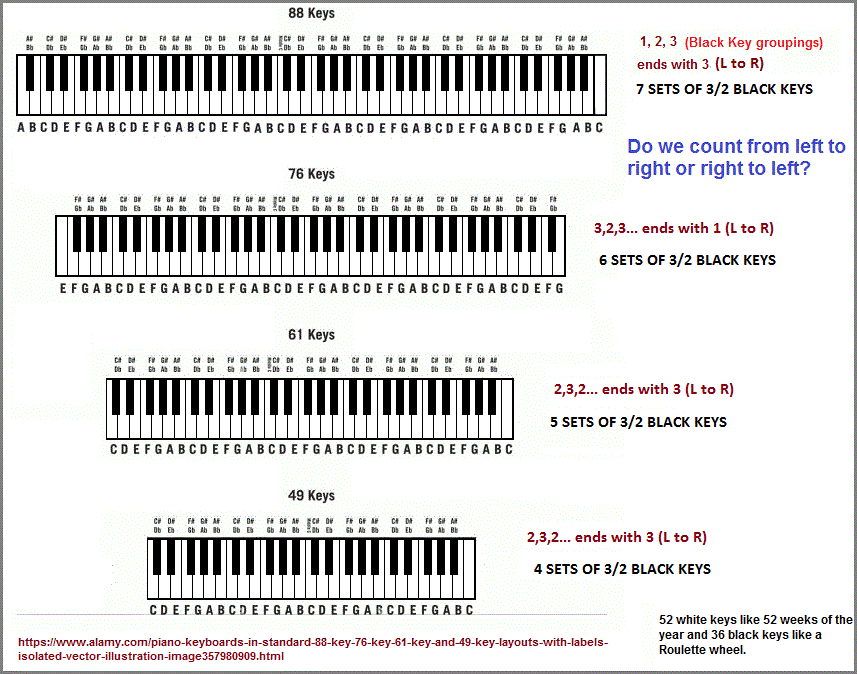
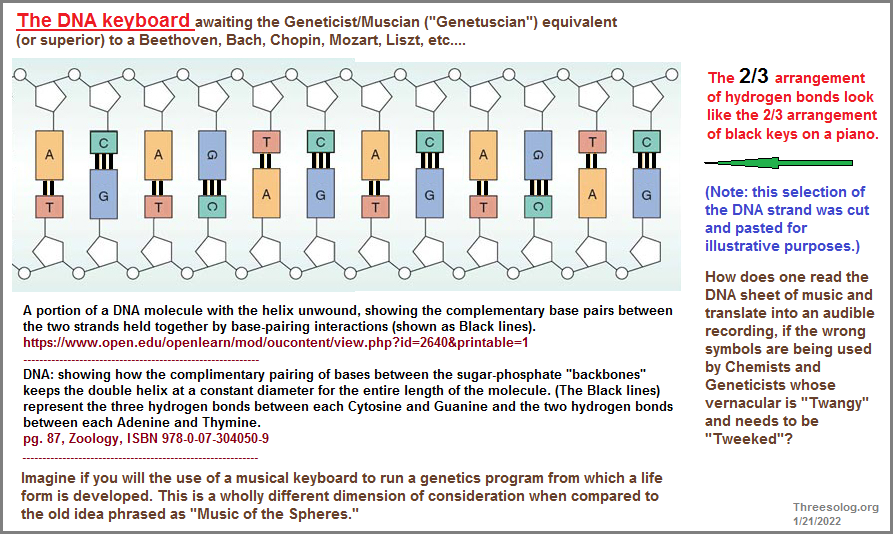
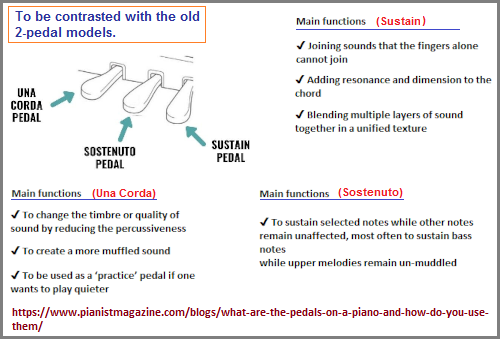
Apparently, the usage of two pedals became a recurring standard in later European models while a third (Middle) pedal was added later by (the later-born European linked) American manufacturing culture. If we look further back in time and associate the usage and naming of a third item with the practice of labeling individuals with their own names... (like the development and usage of a dewey decimal system required when the population of books increased); let us note the cognitive development of humans in using a single name, then in some cases a double name, and in many (but not all) cases a third name, with more than three reserved for alternative descriptions such as using both a mother's and father's surname or due to a title. In several cases we find that a person becomes attached with an abbreviation that may be singular, double or triple. In fact, the names of gangs, clubs, associations, etc., has maintained this same cognitive orientation.
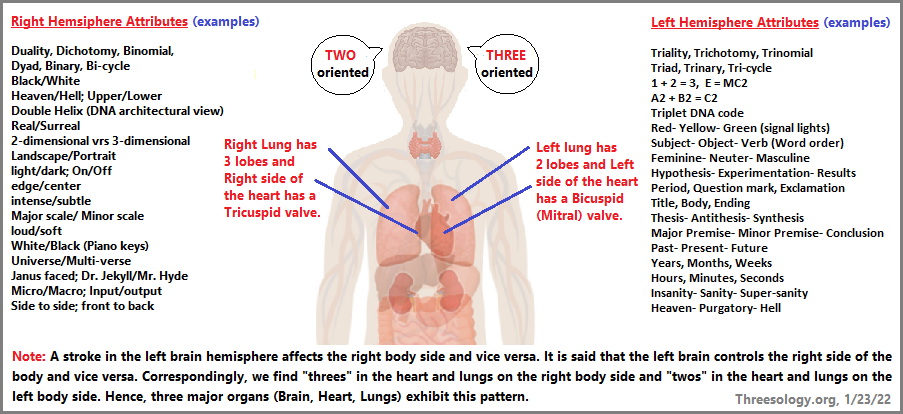
For a further reference to the above image see this page: Hybrids in Language 3. The body graphic came from here: Virus Organs Graphic.
An older reference to the "2 versus 3" idea can be seen on an image from Pompeii.
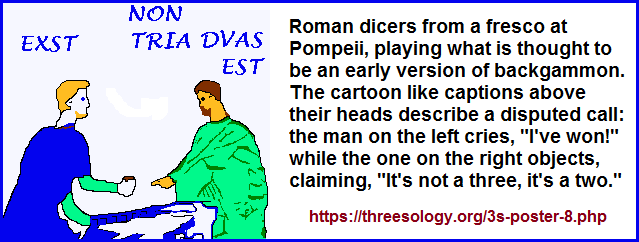
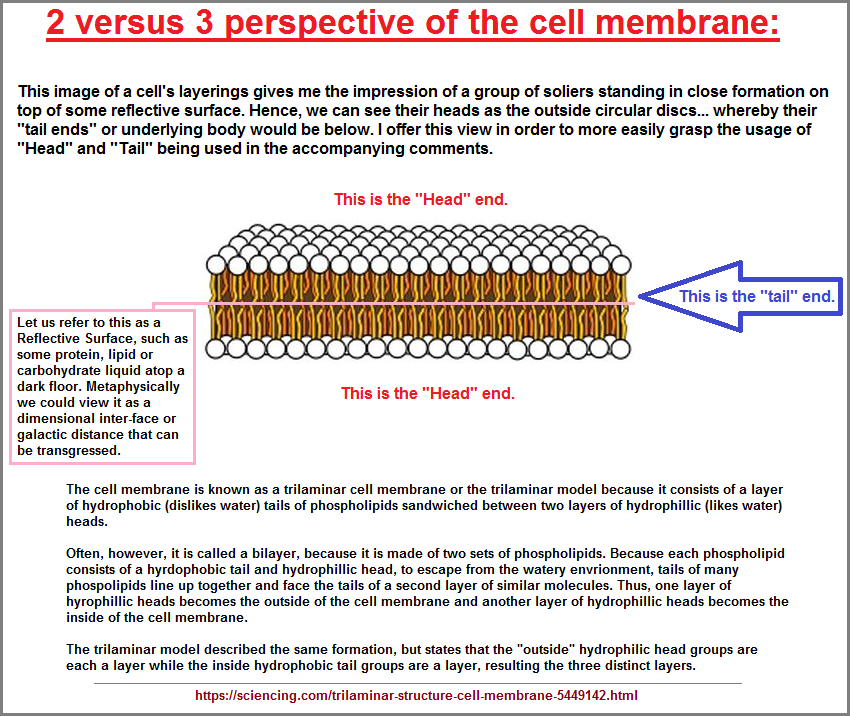
The adoption of a third element and a particular insistence on a "threes" orientation is said to be a given for the (Later born European linked) American (non-Native American) culture, with their (Earlier born) European counter-parts having had a previously established two-patterned focus and more primitive or earlier cultures (following the ascent of humanity's evolutionary advance); preferentially focused on the singular group "self"-survival identity. Multiple names for an individual are not needed in a small population, though a larger population may have a need for establishing a family name; such as having it designated as having the greater importance than any single individual, and may well refer to themselves first by supplying their last name... as in the case of many Traditional Chinese groups.
The point being is that we can see variations in which the underlying standard cognitive model exhibits itself in various applications and practices, accompanied by the necessary rationale and philosophical supports using either a monism/dualism, or monism/pluralism, or dualism/pluralism, or monism/dualism/tripleism, or triplism/pluralism, or some other combination which renders an underlying similar cognitive count that may use words which do not plainly represent enumeration. It's as if the human brain is carrying out some type of counting and sorting routine, even if most individuals are not conscious of doing so. It reminds me of birds or other animals who have been noted as having an ability to count and carry out their manner of "computation" in their daily lives seemingly oblivious to their activities involving repetitive counts. So too is the case for animals called humans. There are of course exceptions to the Standard Cognitive Pattern like there are exceptions found in other designated rules of thumb such as the Octet Rule in Chemistry, Fibonacci series rule in Botany, etc. Exceptions to a supposed rule may well be established as a cognitive rule itself, but as a rule, its presence on a graph aligned with other patterns may well be viewed as commensurately minor.
Many covalent molecules have central atoms that do not have eight electrons in their Lewis structures. These molecules fall into three categories: Exceptions to the Octet Rule
- Odd-electron molecules have an odd number of valence electrons and therefore have an unpaired electron.
- Electron-deficient molecules have a central atom with fewer electrons than needed for a noble gas configuration.
- Hypervalent molecules have a central atom that has more electrons than needed for a noble gas configuration.

Hmm, let us wonder if human cognitive development has the capacity to follow a Fibonacci sequence and would naturally do so if it weren't for the obstacles which some may say are created by business, political and religious indulgences, not to mention other interests... along with a deteriorating environment.
It should be mentioned although we think that the "DNA rule" (that all life forms have it), the hypthesis of a (single stranded) RNA world which preceded the present (double-stranded) DNA world, suggests there may well be a life form that is RNA positive without having any DNA. Due to the diversity of microbial life forms, where it is thought such a creature is best to be found. Does a DNA-less cellular organism exist on Earth? Akira Hiyoshi, Kohji Miyahara, Chiaki Kato, Yasumi Ohshima
The 1-2-3 cognitive pattern (or its variations such as 1-2-many, 3 as 1, 3 into 1, 1 out of 3, etc...), is seen in the standardized usage of 3 pedals for pianos, whereas a two-pedal version had initially been introduced to the U.S.. Label it a trinity, a syllogism, a triple header or whatever, "three" convention you are most disposed towards, the three pedals can as well be viewed in terms of the dominant naming convention exhibited by the U.S.. One might view this from the perspective that earlier born cultures made use of a single name, the usage of two names was a later phenomena which was followed by the usage of three names as developed by the ancient Romans from which it is said the later born culture known as the U.S. adopted. This is not to say that the usage of more than three names [First (given name), Middle, Last (Surname)]; but such practices appear to be more in line with Ego-attenuated titles. Nor is a reference about a naming trend to claim that single and double names are not widely used in some cases... but that the one- two- three naming convention can be argued as another example of an existing cognitive model exhibited by the triplet code in DNA and the fact that life as we know it is on the 3rd planet from a source of solar energy. No less, there are occasions when a "one" or "1" reference becomes discarded or fused into one or more such that we may not have a three-patterned 1-2-3 ensemble, but a three-patterned The Devil's Advocate, page 14a (2-3-4 modeling), as well as can be seen in the three-patterned Pythagorean formula of 32 + 42 = 52. No less, the classic paper of Miller's entitled The Magical Number Seven, Plus or Minus Two, is all too often overlooked as a three-patterned ensemble of 5-7-9.
.
- History of Naming
- Surnames by by Ellen Castelow (British culture surnames)
- Mononymous Person (Person with one name)
- U.S. Southern culture using double names (Billy jo, Mary Grace, Sue Ellen, Anna Claire, etc..)
- Roman Naming Conventions (The "tria nomina", the combination of praenomen, nomen, and cognomen that have come to be regarded as the basic elements of the Roman name.)
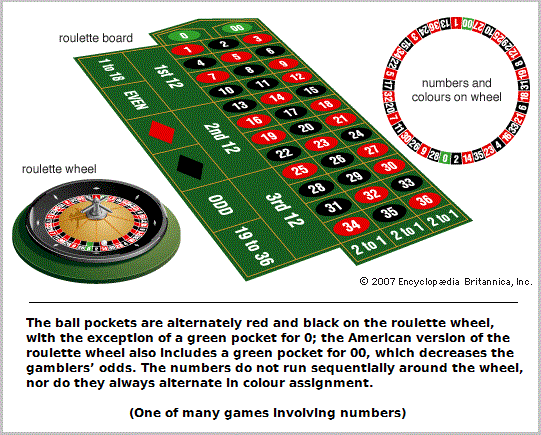

Why do the numbers on a Roulette wheel add up to 666?
Referencing the idea of a "One- Two- Three" pattern signified as a "One- Two- Many" phenomena where the word "many" can take on different labels such as varied, much, heap, more, a lot, bunch, etc., the fact that we can recognize such a pattern in the pterodactyl limb does not speak for instances which can well speak for themselves such as in the case of language (or speech) development. When we find a recurrence of the pattern in yet another faculty of the human physical dimensionality, it suggests there may be other occurrences which have not been catalogued nor become part of a discussion revolving around the origin of such a developmental pattern. Since it is not likely that a reader of this page would readily attribute the pattern towards an influence of thought, not so is the case when we find it occurring in a facility of language development where the idea that words influence thoughts, we need to address the recurring phenomena as a tell-tale sign that something more fundamental has occasioned such an existence, and how it may well play out in other sociological concerns involving business, government and religion.
Whereas we can see the pattern in the development of using words to describe quantities which later become associated with some numerical referencing symbology such as a line, notch, circle, etc., the fact that we come to use such a pattern to organized perceived behavioral activity may not be a coincidence and have a meaning beyond the initial design and usage, as if the "One- Two- Many" is an utterance of speech related to some cognitive function for which we humans in our present state of evolution grope crudely with in our attempts to convey some indistinct image bounding back on the walls in our psyche, like a moving shadow seen from the perspective of someone watching the passage of the Sun as it exerts itself as a shadow on a wall. In any respect, it will be useful for some readers to become aware of language development stages, where the "One- Two- Many" can be easily differentiated:
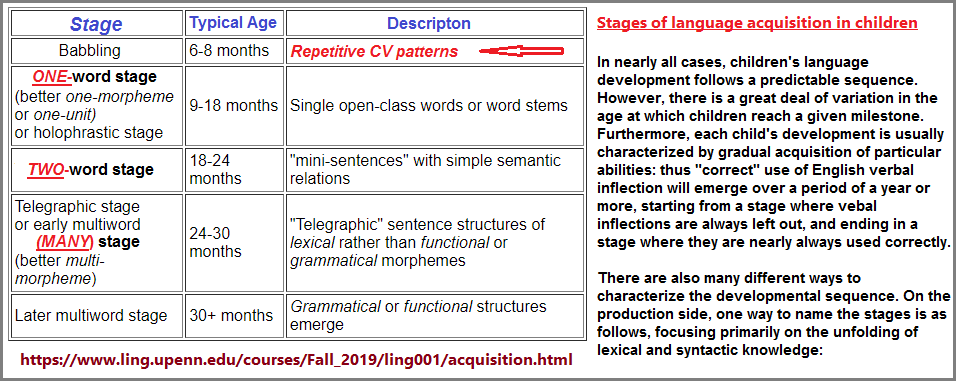
Let's explore the attempt to define the parameters of a proposed Standard Cognitive Model with respect to a pattern-of-three Linear, Circular, Triangular conformation; viewing it as one of several approximations devised by the human brain. However, it is to be noted that when I say "standard", I am not also claiming some easily referenced identical form. Creativity, serendipity and originality can come into play just as does mediocrity. And though I say "standard Cognitive Model", it might appear to some readers that the last word (Model) should be pluralized to read "Models"; since the standard appears to be made up of multiple ensembles which we can collate together by looking upon human perception and mental activity as one might view and use an artist's color palette, fisherman's tackle box of lures, or even the famous "box of stuff" set aside at the back of a closet, top of a shelf, placed in a shed, the garage, attic, basement... or set nearby such as a kitchen "junk drawer".
This being said, we need to be somewhat flexible in our thinking since "different similar" (or is that "similarly different"?) ideas cropping up under different circumstances (such as attitudes and preferences for traditional designations)... can be labeled and dressed differently. An expressed idea can sometimes take on an embellished abstraction, "stick man" or seemingly non-syndical doodling configuration... as well as various interminglings of language and ideas from different subjects combined together, used as substitutions, whittled on, etc... And yet, for those wondering, the usage of mathematics as an attempted standard model of thinking is problematic, because mathematics is itself a recurring pattern that is not being viewed as a variable, along with the recurring emphasis to use linear and static equations to represent dynamic and non-linear processes. The basic patterns of mathematics are being excluded from being recognized as variables in equations. It requires a different type of Calculus to do this.
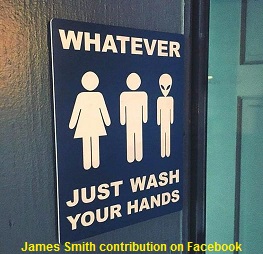
A standard cognitive model apparently contains ensembles of three in which three forms can interact, inter-mingle, overlap, inter-play, and produce other types of conjugations that may be alternatively termed as a 3 in 1 ratio, instead of as a 3 "to" 1, 3 "from" 1, 3 "and" 1, 3 "also" 1, etc..., such that reversals of this may be linguistically portrayed as well as derivations. Fore example, 3 minus 1 3 times1, 3 divided by 1, 1-cubed, etc... An example of how a given pattern such as the idea of "three being represented by one" can crop up in multiple scenarios in different cultures in different time periods in different subjects and be portrayed in a modern setting, is found in the physics idea of The Grand Unified Theory (GUT); where the three forces (electro-magnetism, strong, weak) are considered as possibly being one force. Hence, this 3 being 1 can be viewed as a type of ratio, with alternative words and symbols placed between the two values, as one might place the word "unity" between the values of Yin and Yang.
The "Yin and Yang" idea is often considered as a list of opposites, though not infrequently viewed as complimentary and complementary items with great utility, and might well be viewed as an early attempt to devise a standard by which all of life can be and should be viewed. However, I see the Yin/Yang idea as but one of three pattern-of-two profiles, which should be of interest for those who contemplate the notion of opposites:
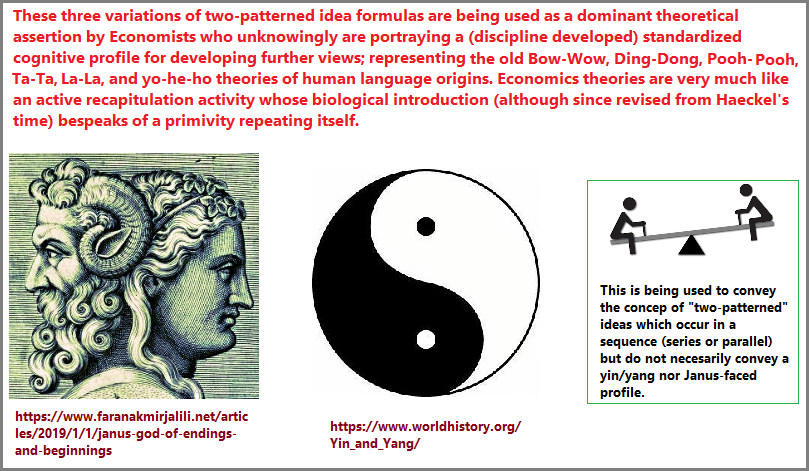
Clearly, the hot/cold, wet/dry, stormy/calm, etc... climates of Earth along with the bipedal (pendulum) influences of the human gait have contributed to a retention of the old double-entry cognitive pattern seen in religions, politics (such as political factions), fashion, dance, sexual orientation (the "Pride" community is even more primitive with its advocacy of single entry accounting), and multiple other human activities. Nonetheless, though most people take opposites or patterns-of-two for granted, and one can surmise that individual perception can determine the definition of what is meant by opposition, let us attempt to conjecture the existence of a finite quantity of the "two", irrespective of the labeling one might select to appropriate as the preferred vernacular, in that there is a lingua franca of kinds one might be able to deduce. For example, we have the oppositional form of the "two" as expressed by the Yin/Yang profile. We also have the series type of two such as in the case of a one- two progression, though we might wrestle for a time with the two-pattern represented in the fashion of a direct current example with its direct positive and negative orientations. With this in mind we come to a "two" in which a type of reversal appears that we might denote as Alternating current. From these observations one might step in the direction of allocating to our collection of twos, the item we call parallel, or a side-by-side pattern-of-two. And if we think about an inter-dimensional linkage, it is not certain whether we have actually found a different type of "two-pattern" or just an elaboration of one or another already cited in our three-dimensional perspective. By extension, if we view the "two" in relation to the three movements one might use when changing the direction of a chess piece, can we thus define the "two" in terms of a horizontal, vertical and diagonal frame of reference which then details three different possible types or kinds of the "two"?
It is not difficult to see that the Grand Unified theory is a 3 to 1 ratio which can be detected as a basic cognitive pattern being used in other subjects, but that those using such a pattern in their preferred subject and context, might well view the pattern with great distinction and not as a recurring theme of human mental activity. As it stands, the pattern can be viewed as a fixed (but flexible/adaptable) organizational theme which becomes used in different contexts and thus may be labeled differently, as well as exhibit other illustrative portraits. For example, instead of "one" the word singularity might be used. And instead of "three" the word many, plenty, heap, few, much might be used. Clearly, the GUT idea in physics is a 3 in 1 idea and dawns the dress, mannerisms and language consistent with the subject in which the basic pattern is cropping up.
Again, to reemphasize the previous point, let us note that the "Three", from some perspectives of looking at the history of counting, can be viewed as the word "Many", such as in the (three-part) primitive counting scheme of "One- Two- Many". Hence, the word "third" is this linguistic phrase is a substitution for the third item. Whereas some readers might want to argue that the "Many" in the foregoing sequence refers to 3 or more, the fact that the phrase is a three-patterned expression itself, can be viewed as a correlation to the idea of a set-of-three, ... such that the U.S. motto E pluribus unum (Latin for "out of many, one"), can be referenced as a symbolic model of the 3-in-1 idea... yet there are several others: Three to One ratios page A.
Without suitable references from other cultures such as the Asian and African which provide "three-to-one" references, regardless of guises, it is of value to tentatively describe the expression as being related to Indo-European peoples, and thus suggests a long-term linguistic transference through time which has established the illustration as a cognitive theme. The Grand Unified Theory is thus a type of cognitive construction being processed which has a history in Indo-European cultures (that other cultures may have borrowed... unless we find evidence that the opposite is true). For example the idea of the Christian Trinity is such that it is sometimes explained as three persons in one godhead. Prior to this idea was the view... one might assume, that the Sun was made up of three "moments" or phrases (Dawn- Noon- Dusk). Gregor Mendel established the idea of a 3 to 1 ratio in biology.

To me, the "3 in 1" (or 1 from 3, etc...), is so similar in number variables to the expressions "3 to 1", 3 and 1, etc., that I am inclined to view them in the same context of cognitive usage. As the human brain allows for a wider berth of accommodation for particular cognitive themes as a recurring pattern of familiarity as one might use a particular phrase, piece of clothing, mannerism, etc., as an identification. While distinctions may be made on separate applications to satisfy those who are obsessed with a cognitive theme being expressed in a particular way, I think the two (and other variations) are close enough that the human brain categorizes all of them with a "look alike/sound alike" quality, though some readers swear that "tomato and tomahto" are differences which constitute a dissimilarity of great importance. Nonetheless, the phrase 3 in 1... to me, can also be viewed as 3 and, from, out of, into, etc., 1. Hence, when I see us using a comma to separate three items, even though in language we call it a series of three and in mathematics we call it a set of three, the same basic idea is being referenced. Likewise when I see that both DNA and RNA have the same three amino acids, and then are distinguished by as separate one [respectively: Thymine/Uracil], the usage of some to call the association a group of four instead of a three-to-one ratio does not change the fact that the human mind has configured perceptions in a similar way. The Grand Unified Theory in physics may be an idea which references a linguistic tradition of a similar cognitive behavior that we might want to reference as a (part of a) Standard Cognitive model.
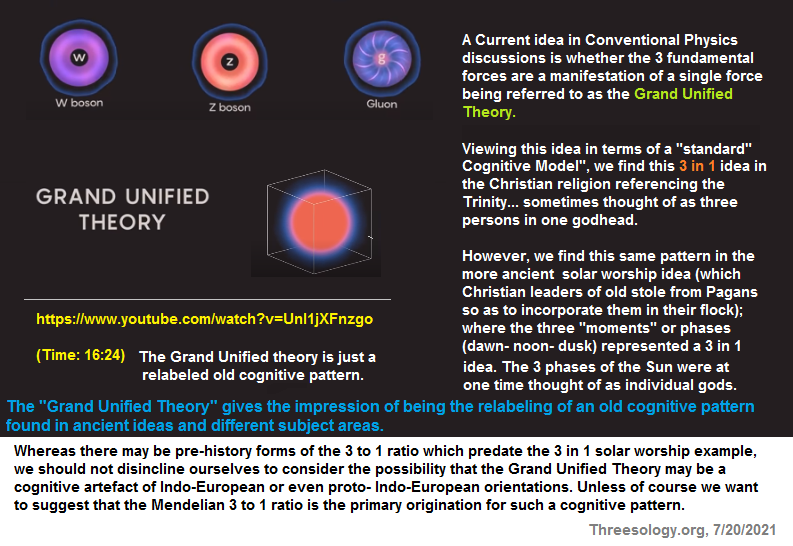
Despite those readers who are inclined to describe four forces and four directions and four amino acids instead of a "three" theme, let me again point out that there needs to be a "3-to-1" label of referencing placed into our research and descriptive formulas. Three items can be distinguished from a single one, if not by place of position, activity, labeling or use of some conventionalized demarcation such as a comma, then by a deliberate act of seeking to review our ideas in an alternative manner. Hence, when viewing the 3/1 (or: 3\1 or: 3_1 or 3:1, etc...) we have such examples as:
Here are some various 3 to 1 examples meant to be shown as a recurring cognitive pattern showing up in different guises. Recurring cognitive patterns illustrate recurring environmental and social pressures being created by and subjected to the incremental deteriorations of the Sun (it's burning out), Earth (it's rotation is slowing), and the Moon (it is receding); to which humans produce rationalizations (such as business, politics, religion... superstitions, traditions, holidays... etc.) as a make-shift survival mechanism and an attempted coping mechanism.
- Three: Electro-magnetism, Strong, weak forces... One: differentiated Gravity force (Why Gravity Is Not Like the Other Forces)
- Three: North, South, East... (demarcated by a comma) One: West
- Three: (the same amino acids) Adenosine, Cytosine, Guanine... One: (differentiated single amino acids) (DNA = Thymine), (RNA = Uracil)
- Three: Stop codon amino acids... One: Start codon amino acid
- Three: (A colloquialism) "We teach the ABC's"... One: All the rest of the alphabet is not typically used to describe teaching the alphabet.
- Three: ones, tens, hundreds... One: (demarcated by a comma) before the thousands is placed... and then the sequence repeats like a babbled utterance.
- Three: "For he's a jolly good fellow" (repeated 3 times)... One: (followed by the phrase:) "For which nobody can deny"
- Three: Dawn- Noon- Dusk... One: Sun (Three "moments" of phases in one Sun.)
- Three: Solids, Liquids, Gases... One: Plasma
- Three: (spatial dimensions) Depth, Width, Height or Width, Breadth, Height; (point, line, plane) [3 dichotomies: up and down, left and right, back and forth]... One: Time (dimension)
- Three: Length, Width, Height... One: Volume
- Three In One: The gas laws consist of three primary laws: Charles' Law, Boyle's Law and Avogadro's Law (all of which will later combine into the General Gas Equation and Ideal Gas Law). The three fundamental gas laws discover the relationship of pressure, temperature, volume and amount of gas. ( Gas Laws). Gay-Lussac's Law refers to an ideal Gas. Other laws deal with Real or actual laws. Hence, a dichotomy is differentiated.
- Three: Father- Son- Holy Spirit... One: God (Three persons in one god-head)
- Three: Three main engines... One: Space Shuttle (Three rocket engines in one space shuttle.)
- Childhood game of four-square features four possible players with one acting as the initial server of the ball.
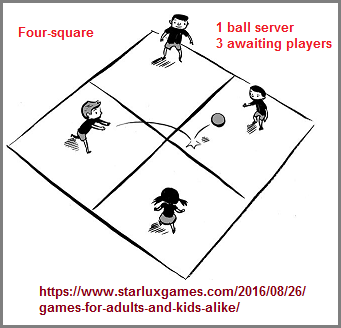
- Three: Premium, Mid-grade, Regular (gasoline)... One: Diesel fuel oil
- Playing three to one: British slang referencing the penis and two testicles set against the one vagina.
- Three: A protein's sequence of amino acids (or primary structure), determines Secondary and Tertiary structures. All proteins have primary, secondary and tertiary structure... One: Some proteins are made up of more than one amino acid chain, giving them a quaternary structure. (Protein Structure Tutorials)
- Three: Buy three tires... One: Get one free (or for a dollar)

- Whalefish Researchers have discovered that a group of deep-sea fishes previously classified into three separate families are actually the larvae, males, and females of a single family -- the whalefishes. (Researchers show that three fish families are actually one)
- War time perspective: Never light three cigarettes with one match (because a sniper can then locate your position). Phrase Finder: Three on a match
- Myth: You are never more than three feet from a (at least one) spider. ( Myth: You're always within three feet of a spider)
- The One infamous electric eel is actually three distinct species. (The Truth About Electric Eels Has Long Been Overlooked)
- Three: Matthew, Mark, and Luke are called the Synoptic Gospels... One: John is called the idiosyncratic gospel.
- Three: Superman, Perry White, Jimmy Olsen... One: Lois lane (Superman television series of the 1950s in the U.S.; Three main male characters to one main female characters.)
- ETC...
|
3 commonly referred to monkeys: See, Hear, Speak no evil 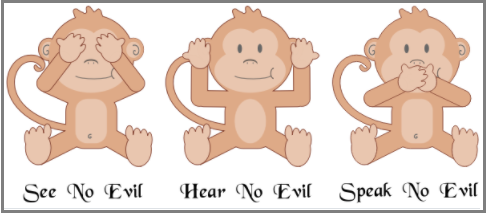 https://openclipart.org/detail/283580/4-monkeys-improved |
1 commonly unknown Monkey: Do no evil 
|

Date of Origination: Saturday, 14th March 2020... 6:11 AM
Date of Initial Posting: Friday, 8th May 2020... 4:48 PM
Updated Posting:Saturday, 26th July, 2025... 4:52 AM